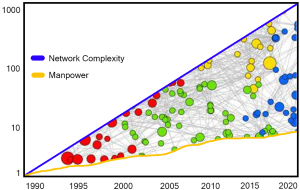The Weakest Link
Today, TrendMicro announced their discovery of Emmental, proof that “…online banking may be full of holes.” The focus of the attack is on users of online banking, and it, like many of the current attacks, starts with a phishing attack on consumers. The New York Times Bits Blog covered the report, as well, providing a high-level view of the attack on two-factor authentication used by many online financial sites.
 This attack unimagederscores two vital truths:
This attack unimagederscores two vital truths:
- The weakest link in security is the human factor, and
- Trust is the key to security
In Emmental, the cyber-criminals used the combination of fear for their finances and trust of consumer brands to convince consumers to open attachments and visit financial sites that had been created to capture their usernames, passwords, and PINs. The holes exploited in this process are many, including email systems, operating systems, web browsers, and the wide variety of multi-factor authentication in use.
It can be easy for enterprise technology specialists to write this off as simple error on the part of the unwashed consumer masses. Yet, these issues and truths exist within enterprise environments, and we see this consistently: simple typos and conceptual errors in device configurations lead to violations of security policy and potential breach paths, misunderstandings of policy intentions result in open access, and IT organizations trust more widely than is prudent.
How do you protect your enterprise from these risks while recognizing these two vital truths?

 “It’s a reflection of the age we living in. People are always trying to steal information” The main problem that encourages this kind of illegal activity is that it’s really relatively easy. Nobody thinks the hacker who stole the information from the Astros was heavily funded by a foreign government, or anything like that. Indeed, it’s quite possible the person or people involved had no more motivation than curiosity, and found it easy to get in. The challenge, of course, is that every business has secrets – how it approaches negotiation, or the pricelist for its upcoming products, or its next quarter of advertising plans. All that information is useful to others if it’s exposed. Many businesses like the Astros have treated IT security as a “high end” problem – something for banks, the military, or energy companies to worry about. But it’s just not possible to operate that way anymore – the risk of corporate embarrassment, or worse, is escalating. Attackers are finding our complex defenses are badly deployed, badly coordinated, and easy to walk through. All the attacker needs is persistence, and the search for a forgotten, unlocked “side door” onto the business can be largely automated. Defenders need to understand all the gaps, and how all the security defenses work together, even if their only target is “good enough” security. As the Astros have found, the standards of “good enough” are rising rapidly.
“It’s a reflection of the age we living in. People are always trying to steal information” The main problem that encourages this kind of illegal activity is that it’s really relatively easy. Nobody thinks the hacker who stole the information from the Astros was heavily funded by a foreign government, or anything like that. Indeed, it’s quite possible the person or people involved had no more motivation than curiosity, and found it easy to get in. The challenge, of course, is that every business has secrets – how it approaches negotiation, or the pricelist for its upcoming products, or its next quarter of advertising plans. All that information is useful to others if it’s exposed. Many businesses like the Astros have treated IT security as a “high end” problem – something for banks, the military, or energy companies to worry about. But it’s just not possible to operate that way anymore – the risk of corporate embarrassment, or worse, is escalating. Attackers are finding our complex defenses are badly deployed, badly coordinated, and easy to walk through. All the attacker needs is persistence, and the search for a forgotten, unlocked “side door” onto the business can be largely automated. Defenders need to understand all the gaps, and how all the security defenses work together, even if their only target is “good enough” security. As the Astros have found, the standards of “good enough” are rising rapidly. Collaboration at this scale is required to turn the tables on cyber criminals. The impact of today’s events should not be underestimated: this is bigger than any individual arrest. The global law enforcement community has sent a strong message to the individuals who commit these crimes – You are no longer safe to travel and operate outside of your home country, without significant risk of arrest and prosecution. Isolation is a powerful force in the effort to change behaviors. Confined within the borders of their home countries, I suspect we’ll see a change in behavior on the part of some of these criminals.
Collaboration at this scale is required to turn the tables on cyber criminals. The impact of today’s events should not be underestimated: this is bigger than any individual arrest. The global law enforcement community has sent a strong message to the individuals who commit these crimes – You are no longer safe to travel and operate outside of your home country, without significant risk of arrest and prosecution. Isolation is a powerful force in the effort to change behaviors. Confined within the borders of their home countries, I suspect we’ll see a change in behavior on the part of some of these criminals. This was brought home in a powerful way when I recently attended a cyber security meeting in London. In addition to briefings with a number of industry analysts, this meeting also included a panel discussion with about 15 CISOs from various industries like finance, not-for-profit, publishing, media, banking, and manufacturing. To a person these CISOs said two things. First, their greatest need was skilled personal to run their networks. Second, their senior management was asking questions about not “if” they were breached but what they would do “when” they were breached. This shift in attitude, driven by all the news in recent years about breaches at large, household-name companies, was an “ah ha” moment for me.
This was brought home in a powerful way when I recently attended a cyber security meeting in London. In addition to briefings with a number of industry analysts, this meeting also included a panel discussion with about 15 CISOs from various industries like finance, not-for-profit, publishing, media, banking, and manufacturing. To a person these CISOs said two things. First, their greatest need was skilled personal to run their networks. Second, their senior management was asking questions about not “if” they were breached but what they would do “when” they were breached. This shift in attitude, driven by all the news in recent years about breaches at large, household-name companies, was an “ah ha” moment for me. Unfortunately, we all share significant risks, not least because IT tends towards “monoculture”, with only a few major pieces of hardware and software being used most of the time. Organizations use the common equipment because it’s cheaper, because it’s better understood by staff, and because we all tend to do what we see our neighbors doing. These upsides come at a cost, though – it means attackers can find a single defect, and it can open thousands or even millions of doors, as we recently saw with Heartbleed. This situation isn’t likely to change soon, so it’s welcome news whenever there are more eyes on the problem, trying to find and disclose defects before attackers do.
Unfortunately, we all share significant risks, not least because IT tends towards “monoculture”, with only a few major pieces of hardware and software being used most of the time. Organizations use the common equipment because it’s cheaper, because it’s better understood by staff, and because we all tend to do what we see our neighbors doing. These upsides come at a cost, though – it means attackers can find a single defect, and it can open thousands or even millions of doors, as we recently saw with Heartbleed. This situation isn’t likely to change soon, so it’s welcome news whenever there are more eyes on the problem, trying to find and disclose defects before attackers do. We’ve come a long way since then. So far, in fact, that the NSA has change their strategy in a way that should send a shiver down the back of everyone responsible for enterprise security: They have switched to assuming that security has been compromised.
We’ve come a long way since then. So far, in fact, that the NSA has change their strategy in a way that should send a shiver down the back of everyone responsible for enterprise security: They have switched to assuming that security has been compromised. I think what worries me more are the organizations who know they have information gaps, but don’t treat them as a priority. I see this as driving a car while blindfolded. How is security possibly going to be effective if you can’t map out the infrastructure – the whole infrastructure, warts, labs, virtualization and all – and just look at it, let alone ask decent, proactive questions about how to defend yourself? Imagine physical security – for example, badge reader installation – without having a map of the building, or even a vague idea of the number of doors that need to be secured.
I think what worries me more are the organizations who know they have information gaps, but don’t treat them as a priority. I see this as driving a car while blindfolded. How is security possibly going to be effective if you can’t map out the infrastructure – the whole infrastructure, warts, labs, virtualization and all – and just look at it, let alone ask decent, proactive questions about how to defend yourself? Imagine physical security – for example, badge reader installation – without having a map of the building, or even a vague idea of the number of doors that need to be secured. on the equivalent of a guard sitting at one entrance expecting to see all access attempts when there are other doors to breach and a back fence that can be scaled.
on the equivalent of a guard sitting at one entrance expecting to see all access attempts when there are other doors to breach and a back fence that can be scaled. At first, I didn’t want to talk about data gaps – that sounded like a challenge to good analytics. I was half right. Eventually, enough CISO’s got it through my skull that uncovering data gaps may be pointing to reasons why analytics will be held back, but it’s also major value, in and of itself. I was being dense – if we try to analyze security data, and we find it’s got holes in it, well, this means the security team didn’t know what was going on to start with! Turning up these gaps is one of those inconvenient truths. These days we’ve gotten pretty good at it.
At first, I didn’t want to talk about data gaps – that sounded like a challenge to good analytics. I was half right. Eventually, enough CISO’s got it through my skull that uncovering data gaps may be pointing to reasons why analytics will be held back, but it’s also major value, in and of itself. I was being dense – if we try to analyze security data, and we find it’s got holes in it, well, this means the security team didn’t know what was going on to start with! Turning up these gaps is one of those inconvenient truths. These days we’ve gotten pretty good at it. Today, governments across the world are applying their resources investing in full-time staff to break into systems and networks in other parts of the world. From the Syrian Electronic Army to the People’s Army, the US Government, and organized crime, attacks come from many different sources looking for a variety of results. This means the mentality is professional, organized, and coordinated, and the attackers are motivated by a variety of results, from financial to patriotic.the early days of people breaking into systems and networks, most actors were solo and focused on showing their own skills while demonstrating the weakness of those they attacked. Early viruses and worms (like the
Today, governments across the world are applying their resources investing in full-time staff to break into systems and networks in other parts of the world. From the Syrian Electronic Army to the People’s Army, the US Government, and organized crime, attacks come from many different sources looking for a variety of results. This means the mentality is professional, organized, and coordinated, and the attackers are motivated by a variety of results, from financial to patriotic.the early days of people breaking into systems and networks, most actors were solo and focused on showing their own skills while demonstrating the weakness of those they attacked. Early viruses and worms (like the 